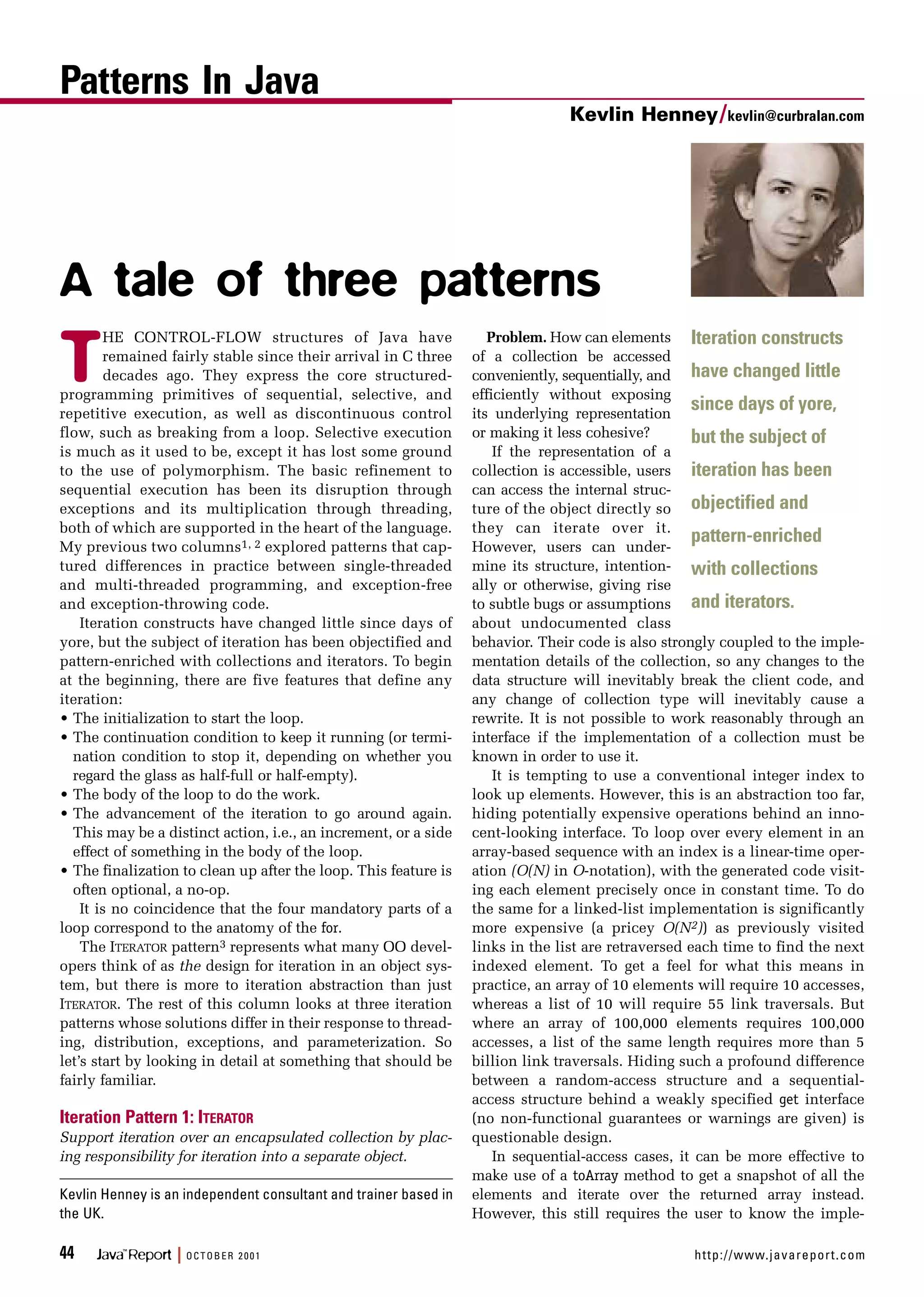The document discusses three patterns for iteration in object-oriented programming: Iterator, Observer, and version stamping. It focuses on the Iterator pattern, which encapsulates iteration logic into a separate iterator object to avoid exposing the underlying collection representation. The Iterator pattern addresses issues like supporting multiple simultaneous iterations, hiding complexity costs, and decoupling code from implementation details. It also discusses strategies for handling iterator validity if the collection is modified during iteration.



![http://www.javareport.com OCTOBER 2001 | Java™
Report 47
for(each key of interest)
{
...
dictionary.put(key, value);
}
for(each key of interest)
{
value = dictionary.get(key);
...
}
While ITERATOR allows traversal of a sequence in an
abstract and controlled fashion, it does not itself address
concurrency and efficiency issues. A COMBINED METHOD
addresses the basic concurrency issues, and can fold three
operations into one; however, this only reduces the num-
ber of accesses, not the number of times a cost-incurring
loop is performed.
Solution. Define a single method that performs the
action repeatedly. The method is declared to take all the
arguments for each execution of the action, i.e., an array or
collection, and to return results by similar means. This
single method folds the repetition into a data structure
rather than a loop, so that looping is performed before or
after the method call, in preparation or in follow up.
Therefore, the cost of access is reduced to a single access,
or a few “chunked” accesses:
interface RemoteDictionary ...
{
Object[] get(Object[] keys);
void put(Object[] keys, Object[] values);
...
}
Each method access is now more expensive, but the
overall cost has been reduced. Such accesses can also be
synchronized as appropriate within the method call. The
trade-off in complexity is that significantly more house-
keeping is performed to set up and work with the results
of the call, and more intermediate data structures are
required. The BATCH METHOD pattern is found in many
distributed system architectures, such as the CORBA
Common Object Services.5 It can be considered as taking
the COMBINED METHOD pattern to its logical extreme in com-
bining many iterations into a single shot.
Conclusion
What drives pattern-based design is not that patterns
embody neat fragments of design—although this is often
true—but that any given pattern can be considered in ten-
sion with one or more other patterns. These other pat-
terns compete as design alternatives, with the trade-offs
in their forces and consequences making all the differ-
ence, pulling the design one way and another. Sometimes
there is a clear winner and the consideration of alterna-
tives does not add anything except time spent mulling
over the detail at the water cooler, on the whiteboard, or
on the way home. However, at other times having a
default case you always apply, without question, can
have quite the opposite effect, accidentally brushing sig-
nificant concerns under the carpet. It is here that having
patterns presented together and in opposition captures
more of the spirit of the design, even in something as
humble and everyday as iteration. s
References
1. Henney, K. “A Tale of Two Patterns,” Java Report,
Vol. 5, No. 12, December 2000, available at http://www.
curbralan.com.
2. Henney, K. “Another Tale of Two Patterns,” Java Report,
Vol. 6, No. 3, March 2001, available at http://www.
curbralan.com.
3. Gamma, E., et al. Design Patterns: Elements of Reusable
Object-Oriented Software, Addison-Wesley, 1995.
4. Beck, K. Smalltalk Best Practice Patterns, Prentice Hall,
1997.
5. Object Management Group (OMG). CORBAservices:
The Common Object Services Specification, available at
http://www.omg.org.
Patterns In Java
Iteration over a sorted binary tree using recursive descent in
an enumeration method
public interface KeyValueTask
{
void apply(String key, String value);
}
public class SortedBinaryTree
{
public synchronized void forEachDo(KeyValueTask toDo)
{
forEachDo(toDo, root);
}
private void forEachDo(KeyValueTask toDo, Node node)
{
if(node != null)
{
forEachDo(toDo, node.left);
toDo.apply(node.key, node.value);
forEachDo(toDo, node.right);
}
}
...
}
tree.forEachDo(new KeyValueTask() {
public void apply(String key, String value)
{ System.out.println(key + “ -> “ + value); }
});
LISTING 1](https://image.slidesharecdn.com/ataleofthreepatterns-150115053857-conversion-gate02/75/A-Tale-of-Three-Patterns-4-2048.jpg)